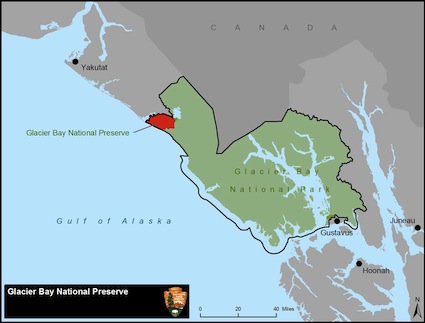I mentioned 12MC reader Scott a couple of weeks ago in reference to the Park You Cannot Visit. He also set me up with a lot of other National Park Service trivia that I’ll cover from time-to-time as I’m able to work it into the publication schedule. As an example, he wondered if I’d ever noticed that some of the parks have an unusual appendage to their names, such as “Glacier Bay National Park and Preserve.”
I’d glanced over that distinction somehow even though I’ve visited Glacier Bay. I guess I though a park was a park, right? Actually no. In the parlance of the NPS, a park and a preserve are two completely separate and distinct units even when they share the same name. Their Glacier Bay map shows this difference quite clearly. Someone who wishes to document a visit to every NPS property would have to travel both to the park and to the preserve.

What Gives Here?
Naturally, I had to know more about the difference since I’d been totally unaware of it up until now. Fortunately the NPS shares its nomenclature and it’s easy to understand.
- National Park: “These are generally large natural places having a wide variety of attributes, at times including significant historic assets.”
- National Preserve: “National preserves are areas having characteristics associated with national parks, but in which Congress has permitted continued public hunting, trapping, oil/gas exploration and extraction. Many existing national preserves, without sport hunting, would qualify for national park designation.”
So, put very simply, a preserve is a park with gunfire. When a preserve and a park share the same name — as with the case in Glacier Bay — hunting is confined to a specific geographic area.
Within Glacier Bay
The NPS and the State of Alaska jointly manage resources of Glacier Bay’s preserve. It is not an easy place to reach and when hunters do arrive they are on their own. However, Grandma on her cruise ship won’t have to worry about stray bullets whizzing by as she floats along the Inside Passage watching glaciers calve. The preserve is far removed from the touristy areas of the park.
“[It] is accessed by air, and involves a 50-mile air taxi flight from Yakutat. There are no scheduled flights. The NPS maintains two airstrips at the Public Use Cabin and another near the rafter take out and Ranger Station. Several small airstrips and beaches provide other landing spots… There is one big game hunting guide authorized through concession contracts to operate within Glacier Bay National Preserve.”
That’s going to be one tough park stamp to earn.
A Range of National Preserves
I also wondered if National Preserves were common, and how often they were appended to National Parks. There are nineteen in total. Half of them are combined with other properties. I also noted that many of them were located in Alaska which I guess makes sense.
- Aniakchak, Alaska*
- Bering Land Bridge, Alaska
- Big Cypress, Florida
- Big Thicket, Texas
- Craters of the Moon, Idaho*
- Denali, Alaska**
- Gates of the Arctic, Alaska**
- Glacier Bay, Alaska**
- Great Sand Dunes, Colorado**
- Katmai, Alaska**
- Lake Clark, Alaska**
- Little River Canyon, Alabama
- Mojave, California
- Noatak, Alaska
- Tallgrass Prairie, Kansas
- Timucuan Ecological and Historic, Florida
- Valles Caldera National Preserve, New Mexico
- Wrangell-St. Elias, Alaska**
- Yukon-Charley Rivers, Alaska
* National Monument and National Preserve
** National Park and National Preserve
A Modern Designation
National Preserves are a relatively new phenomenon within the National Park Service inventory. The first two, Big Cypress and Big Thicket date only to 1974. By contrast the first National Park, Yellowstone, arrived a century earlier.

Big Cypress was supposed to have been part of Everglades National Park but the land was owned privately and money wasn’t available at the time to purchase it (map). They are both large swampy areas of South Florida with a key difference: Big Cypress has a slightly higher elevation so it’s marked by considerably more tree hammocks. They also have different water sources and drain towards different directions. The preserve is massive — the size of the State of Delaware.
It became a preserve instead of a park due to the heated debate at the time of its creation.
A Different Kind of Model
National Preserves also provide adequate flexibility to try new types of management and partnerships that don’t fit within the traditional National Park model. Such is the case with Tallgrass Prairie National Preserve in Kansas.

Tallgrass Prairie is one of the newer NPS sites, joining the fold in 1996 (map). The unique aspect of this preserve is that the vast majority of its acreage is actually owned by the Nature Conservancy. That is why there are websites available from the both organizations, the NPS and the Nature Conservancy. They manage the land cooperatively. In return Tallgrass Prairie gains legitimacy and an additional level of protection under the auspices of the Federal government. May believe that this may become a model for future parks and preserves.
Administrative Note
Totally unrelated to today’s topic: I finally got the redirect working on the Complete Index, the interactive map of all article I mentioned back in June. A couple of you asked when that might happen, so now it’s done. You can either select the link at the top of the page or on the sidebar and it will take you to the same place directly.

Leave a Reply